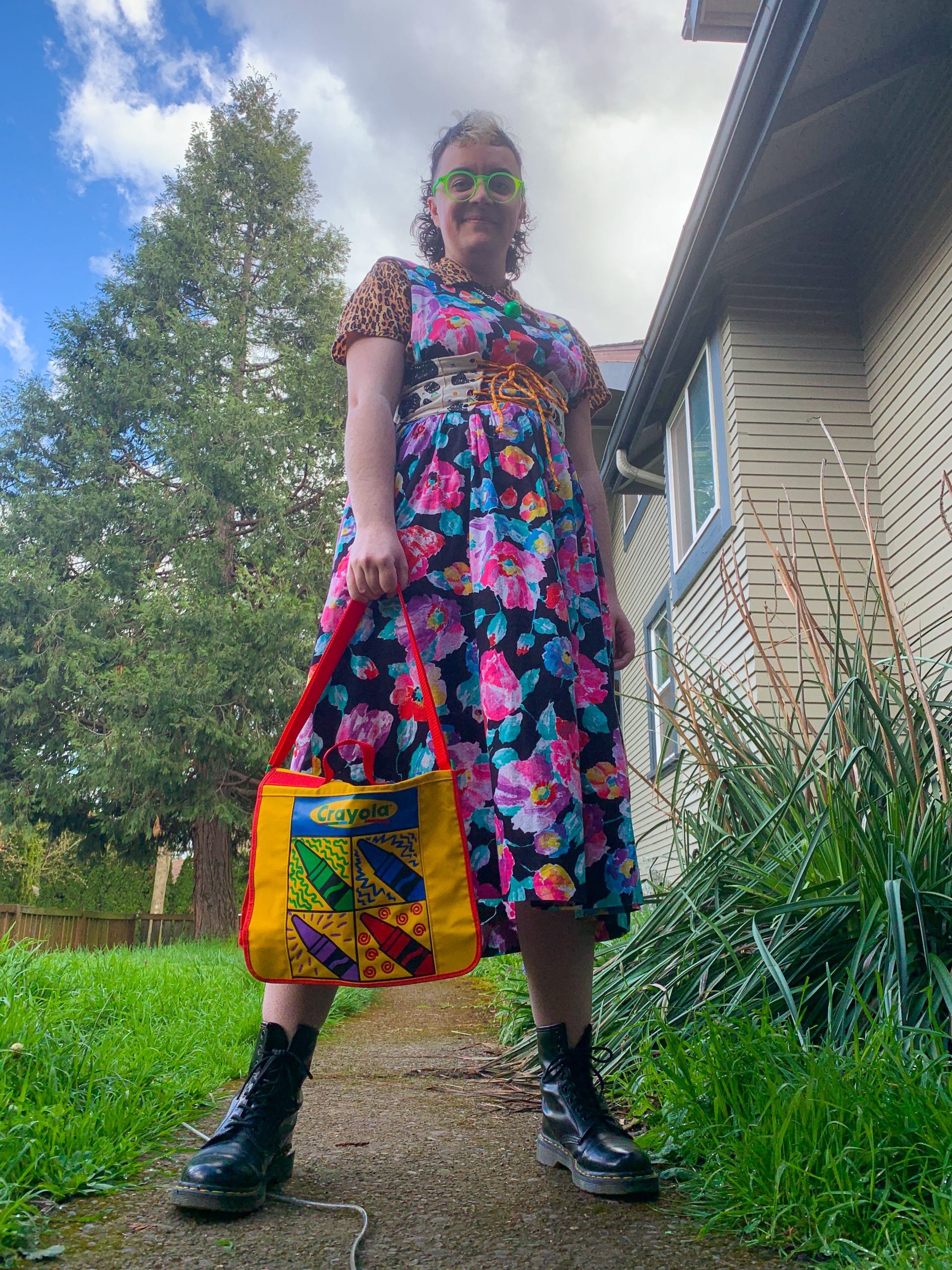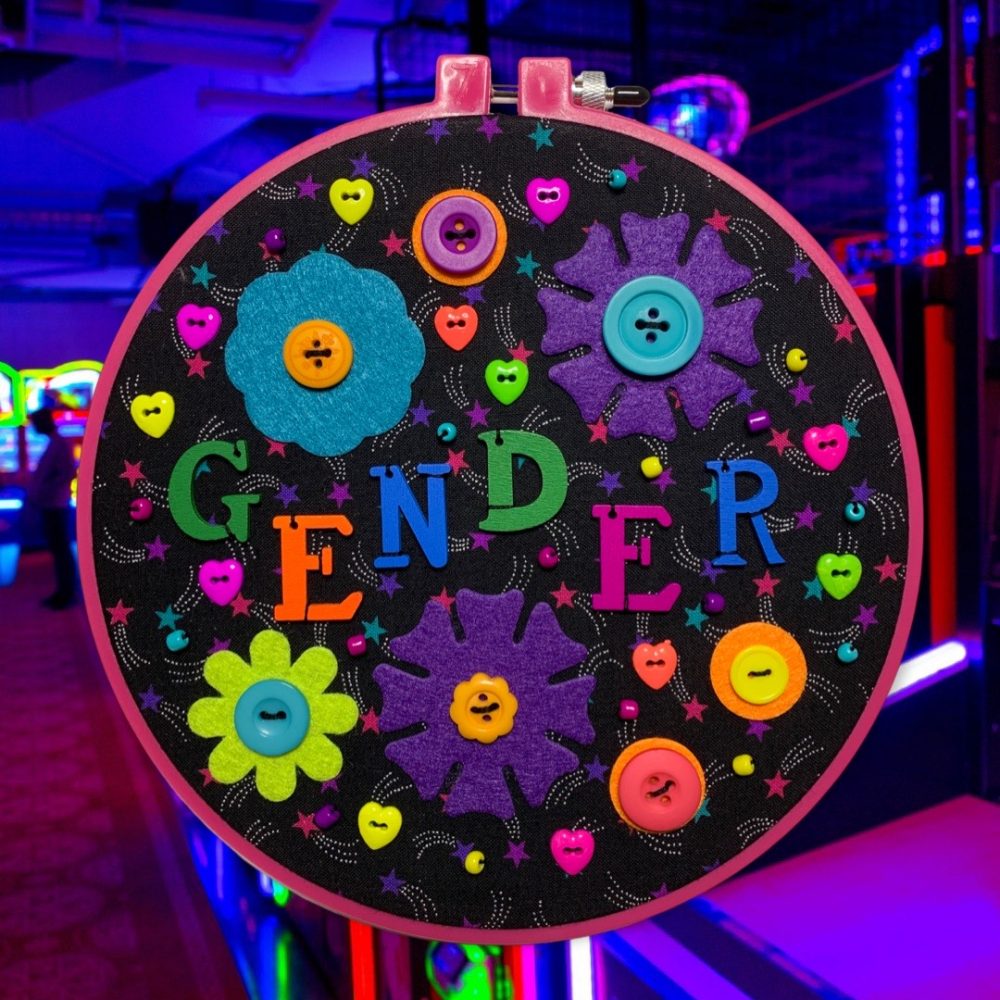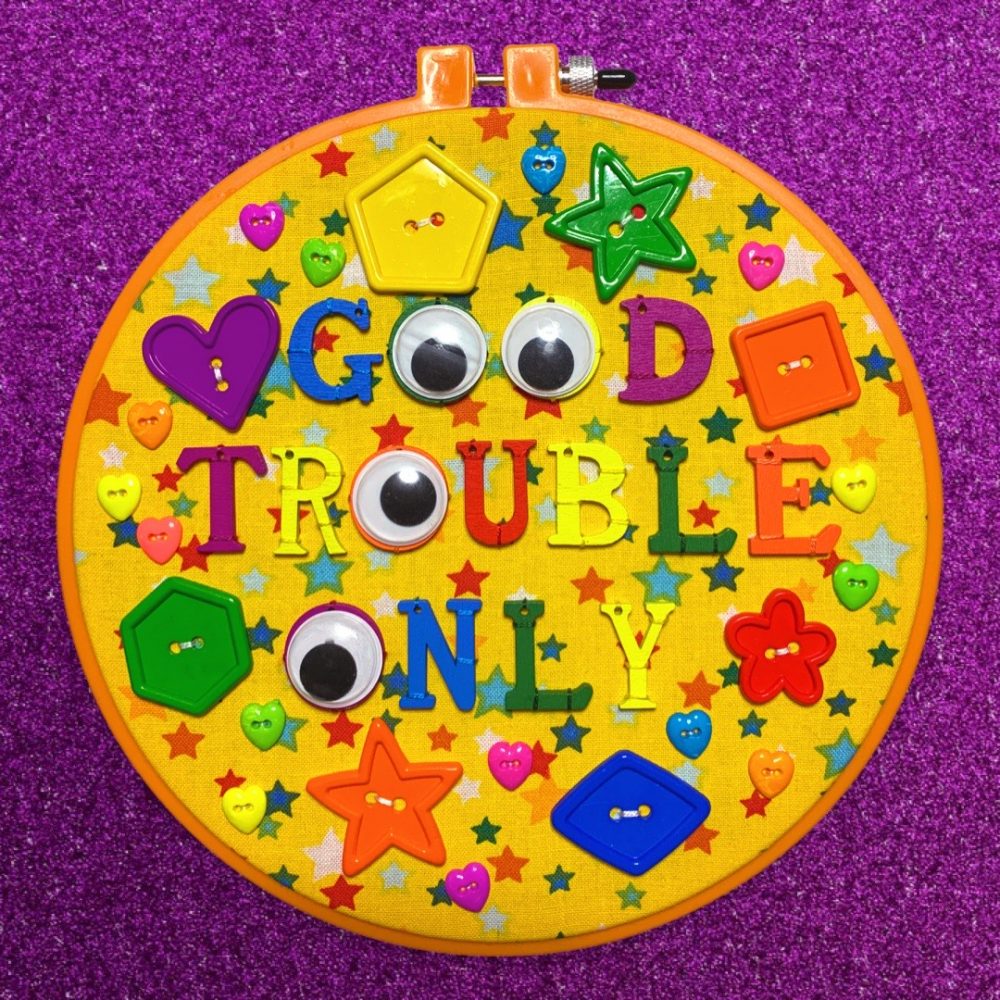Photo by Juniper Harwood
In this next piece for the Disability Pride Month series, we are spotlighting Juniper Harwood (it/xe), an Autigender artist who brings aspects of its life and xyr opinions into its artwork, including the mediums of embroidery, beadwork, stickers, and more.
I thoroughly enjoyed talking to Juniper about our experiences being neurodivergent people, figuring out our identities, and the importance of representation and inclusive vocabulary. Please enjoy reading our third installment of the series!
Giulianna Vicente: If you want to start off with a little bit about you, that’d be great.
Juniper Harwood: My name is Juniper Harwood. I use it/its and xe/xem pronouns. I am 26, I live in the Pacific Northwest with my partner and our dog Cedar. I mainly do art for my work, but I also have done writing and research for YouTube channels. I do image transcriptions, I work at a local community market; I have my fingers in a lot of pies. The majority of my work centers around art with themes with bright colors, fun patterns, a lot of Y2K nostalgia, with some leftist stuff thrown in there, too. I am autistic, I have a connective tissue disorder, and identify as neuroqueer and an Autigender lesbian. That’s me.
GV: Awesome! So what I want to first start off with is your art because it is, as you said, a big part of you. What got you into art and how do you use your art as a form of activism and advocacy?
JH: I’ve always been really artistically driven. Some of my earliest memories are of me singing songs with my dad while he played guitar or just doodling on giant notepads on the floor of my grandma’s living room…I started theater in third grade. And then in high school, I started picking up drawing again after taking a break for a while because I just wasn’t feeling super confident; I was just going through a lot at the time, and I knew that I needed a way to bend emotionally.
I started doing embroidery work in 2019, I think, and people started taking interest on Instagram, like friends wanted to buy it, which was cool. But then people that I had never met wanted to buy it. I started making stickers just to slap around town… *laughs* I would never do anything like that *laughs again*. [I started] making stickers about lack of accessibility and community, and people started wanting to buy those, too…I was able to quit my job in early 2021; I’m a little past my year mark of quitting my “Job” job to make art, which has been really fun. For me, art has just been a way for me to express things that I am feeling frustrated in, mostly, and being multiple marginalized and living in the society that we do right now. [It] just felt natural that a lot of political themes would show up in my work; it just feels inherent to me. I feel I was designed to rock the boat sometimes. I love finding a clash in my work of silly 90s nostalgia themes, but also throwing ACAB on it in big letters as a way to get people’s attention. Make it feel friendly and silly, but there’s a deeper meaning behind it.
GV: I definitely resonate with that… and also I feel like most identities end up being political [with diagnosing and school accommodations availability]…
JH: I just feel I’m at a point in my life where I needed accommodations in school that I didn’t get because I was undiagnosed. I needed accommodations in work that I didn’t get because I was undiagnosed. But now that I mostly work for myself, I can accommodate myself. Yeah, it’s so obvious that I’m autistic. I don’t question it for a second.
GV: With all of these things of political basis, how do you think gender identity and disability intersect for you [specifically] or in general?
JH: It’s all the same [for] me. Like I generally identify as neuroqueer, but more specificallyI’m Autigender in that my autism and my gender are just one and the same. I came out as trans when I was 17 and I hit like, 24 and realized that I still hadn’t found a word or a label that felt correct for me, I was struggling and stressing myself out trying to figure out who I was or what I was…Then I found out about Autigender and how it’s so common for autistic people to identify as queer and to be trans because we just have difficulties figuring out what social constructs mean. And I was just like “Oh, I haven’t been able to find a label because I don’t understand any of it. None of the rules make sense; I don’t get it. And this is why I’ve been struggling. This is why nothing feels right, because I don’t think I’m any of these things at all.” And that’s definitely because of my autism. So for me, it’s the same thing. I can’t pull them apart. I think my queerness, in general, and my neurodivergence are the same thing.
A multicolored embroidery piece featuring the word “GENDER” surrounded in chunky beads of different sizes shaped like flowers and hearts. Photo by Juniper Harwood.
GV: It’s just so cool that we’re slowly getting that vocabulary. And, even though it sucks that words have meanings, it’s also kind of cool that Words Have Meanings. How [do neopronouns] help you and give you representation? How does the use of neopronouns give you access?
JH: Yeah, so I started using neopronouns in the last year or so. I went through a phase where I decided that I was just going to embrace my inner cringe and just do what I wanted with myself. That was when I started looking at stuff, like Autigender and neuroqueer, and I had made friends with someone who used it/its pronouns;I didn’t really understand them until I met this friend. Its name is Light, and it made this top [I’m wearing]. Yeah, I didn’t really get it until I was like “You know what, I don’t care what anyone thinks about me. I don’t understand my gender. I don’t really care either. So I’m just gonna make this.” It’s just like a form of play at this point in gender.
When I started talking to people who used it/its pronouns, I found such a wealth of reasons as to why people use them, and one of them was like a form of reclamation. For me, growing up undiagnosed autistic, definitely mentally ill, disabled, queer… I got bullied a lot. Being dehumanized and being called “it” was a pretty common occurrence for me…It just felt like my time to incorporate my identity into my healing and be like “You know what? Sure, okay. If I use these pronouns, you don’t have any power over me when you dehumanize me.” If someone online wants to troll me and call me an “it” now I just get to say “Thank you for using my pronouns, that was very validating.” And also just trying to get people to recognize that even if you dehumanize me as a queer person, I’m still here. You can tell me I’m not human, but I’m literally right here living my life, so you can’t do that to me. I found using it/its pronouns to be really healing for me, honestly, just taking control of a narrative that’s been placed on me so many times and being like “Sure, I’ll embrace it then.”
The xe/xem pronouns are pretty recent for me. I started using those after I went down a little rabbit hole of neopronoun history. I’ve been trying to build more of a connection with queer history in my life recently and xe/xem pronouns were coined in the 70s and have been around for some of the most important times in…documented queer history, in my opinion. I wanted to find a way to honor that history through my own identity, and using xe/xem pronouns has been a really cool way to do that.
GV: That’s really awesome. So next month is Disability Pride Month. Is it important to have disability pride month, as a month, like having that niche of representation?
JH: I feel a little conflicted with Pride months, only because we live in a capitalistic society where I feel like the message of it rings kind of hollow. It’s the month where everyone pays disabled people, finally, to talk about their lives. I feel conflicted about stuff like that. I think “disability pride” is so, so important as a concept, not as a month with capital letters. It’s so important because I feel that growing up in the time that I have, I’ve seen generally queer pride grow. More people are okay with queer people existing, but it feels there’s still so much stigma around being disabled, where it’s just the last thing you would ever want for yourself. I think it’s really important for us to show that it’s not just that being disabled is okay, or that there’s nothing wrong with it, but there’s so many parts of [being disabled] to genuinely be celebrated. I just wish that that wasn’t all crammed into one month. You know, we’re coming to pat ourselves on the back and stuff like that; I think this should be a year-round thing.
GV: I agree with you that it is very corporate. That was why I wanted to do this whole series piece, too. Even though yes, it is during July, all of us are disabled all year round.
JH: Yeah, that’s definitely how I feel about both June and July. I feel it’s a really good time to highlight these identities. I feel like people are more prone to listening and being curious during these times, but I think it’s just really important to be mindful about what we’re saying and what we’re doing. I don’t want a brand to pay me in July to talk about stuff, but I’m probably going to talk about stuff anyway, just on my own terms. The hashtags will trend and people will want to listen… A lot of it feels a little sour to me, unfortunately.
GV: You said that you do volunteer work. What do you do for volunteer work? Why is it important for you to be a volunteer?
JH: Yeah, so I started doing volunteer work alongside my partner in early 2020. With a nonprofit in our area called TransPonder, which is trans-run and led for the trans community in our area…They noticed at the beginning of the pandemic [that] a lot of people who use HRT [Hormone Replacement Therapy] were having a really hard time getting a hold of supplies, like syringes, alcohol wipes, sharps containers, stuff like that. So they started running a free weekly delivery program where every Thursday we go pick up everyone’s supplies that they’ve requested and we just go and drop it [off] no contact to people’s houses. It’s completely free, anyone can request it.
That was something we took on at the beginning of the pandemic…Originally, it was just a way to get something in our schedules, to get us out of the house during a time where we felt like we really needed to have a good excuse to do so, but it quickly turned into such a wonderful way to connect with our community members, and it is still running years later; we’ve been doing this every week. It’s been so nice to connect with people because so many people are still struggling just getting access to basic supplies to continue their medical transition and I’m so glad that we’ve been able to fill that gap because I feel that it could have so easily been ignored and people are having a hard time getting access to things like syringes.
A bright yellow embroidery piece featuring the words “GOOD TROUBLE ONLY” in multicolored letters with their Os replaced by googly eyes. The words are surrounded by similarly colorful beads of all different fun shapes, and sizes. Photo by Juniper Harwood.
GV: That’s really awesome the organization that you’re in. [Do] you want to talk about your special interests?
JH: We can, I’m worried I’m gonna go on too big of a tangent if I do is the problem…But just in general, my main special interest is theme parks, specifically theme park history — this makes me sound like I’m talking about [a college] major like “specifically Theme Park History with a focus Disney Parks.”
I did some writing and research and some voiceover work for a channel called Defunctland back when that channel started getting big, which is mostly theme park history stuff…That’s something I’ve been interested in for a really long time… I grew up going to Disneyland and other various theme parks as a kid. It’s just been really fun watching those places grow and there’s so much to learn; Disney people are obsessed. There’s so much documentation of every corner of Disneyland and it’s just this never-ending fountain of information. I’m constantly learning new things and I’ve been into this for a decade now.
When I develop a special interest, I want to learn everything and once I learn everything, I do get kind of bored of it immediately. But this one, wonders never cease. I’m constantly learning new stuff; I watch YouTube videos all the time. It brings me so much joy. I recently went to California with my partner and we went to Disneyland to see a historical parade that just came back, which felt extremely nerdy of me to go and do, but my heart was calling for it.
GV: You were saying that you’ve been into [this special interest for] at least for a decade. Does [it] have an influence on your art? How/why do you put everything, from your special interests to political messages, in your art?
JH: Yeah, I recently made a zine in my shop that I’m very proud of that talks about the history of banning same-sex couples from dancing at Disneyland. There have been multiple lawsuits against Disneyland for that over the years. I made [the zine] kind of in response to Disney’s absolute bungling of the “Don’t Say Gay” Bill fiasco. There’s actually quite a rich history of Disney being being very shitty and discriminatory towards queer people, so I’m gonna make a zine about it. I’ll find any excuse to put my special interests in my art because they bring me joy. I feel like a lot of my art focuses around what makes me frustrated, so being able to make fun stuff…brings a good balance to my life.
You can find and support Juniper and xyr art through its Ko-Fi and on its instagram @howdyitsjunebug.
Credits:
Author: Giulianna Vicente (She/Her)
Copy Editors: Emma Blakely (They/She/He), Christopher Ikonomou (Xe/He)



